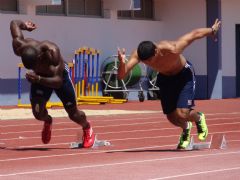Well, after all the excitement of the Olympics, normal service had to resume sooner or later & the Diamond League road show gets back on track tonight in Stockholm, Sweden.
Yesterday, 6 athletes put Team GB duties behind them & hopped on the plane to Scandinavia, amongst them Diamond League debutant, young sprinter, Adam Gemili (pictured above training with Duane (Chambers) in Portugal before we left for London. Olympic 400m silver medallist Chrissy (Ohuruogu) lines up against Sanya Richards-Ross once again, whilst Holly (Bleasdale), Laura (Weightman), Rhys (Williams) also take to the track & Shara (Proctor) will be tearing up the runway in the long jump.
After all the physical (the track in London is fast because it is so hard, which whilst being perfect for the sprinters, really takes its toll on the middle & long distance runners) & mental exertions of the Games, I wouldn't expect to see many earth shattering performances later but there are some 11 Olympic Champions turning out.
Another major difference between sprinters & endurance athletes has been highlighted in a recent study published in Exercise & Sports Sciences Reviews. Margaret Allen from Southern Methodist University wrote the following commentary:
New study: Running mechanics, not metabolism, are the key to performance for elite sprinters
Sprinting performance isn't a factor of conserving energy; Rather, forces applied by the foot hitting the ground maximize all-out bursts of sprinting
Sprinters competing in the 2012 Olympics might assume their championship performance is the result of their fuel-efficient physiology.
But a new study disproves the classic scientific view that conserving energy maximizes performance in a sprinting event.
The study by biomechanics researchers Matthew W. Bundle at the University of Montana and Peter G. Weyand at Southern Methodist University, Dallas, demonstrates that metabolic economy is not an important factor for performance in events lasting 60 seconds or less.
In fact, just the opposite is true.
"That prevailing view is no longer viable," said Weyand. "Sprinters, if anything, are wasteful of energy. This is due to the biological trade-offs between faster muscle fibers that provide the large and rapid forces needed for sprinting, and slower muscle fibers that maximize metabolic economy."
Instead, the key to top-flight sprinting is to maximize how hard each foot hits the ground, which allows sprinters to translate musculoskeletal and ground reaction forces into swift motion, said Bundle.
"Saving energy is critically important for endurance, but not for sprinting, which our findings indicate is not energy-limited," Bundle said.
Metabolic energy available from sustainable, aerobic sources predominantly determines performance during endurance events by setting the intensity of the musculoskeletal performance that can be sustained throughout the effort, the study found.
For sprinters, Bundle and Weyand conclude the opposite is true.
"The intensity of the mechanical activity that the musculoskeletal system can (for a very short time) achieve determines the quantities of metabolic energy released and the level of performance attained," according to the study.
The authors reported their findings in "Sprint Exercise Performance: Does Metabolic Power Matter?" in the July issue of Exercise and Sport Sciences Reviews.
Sprint performance variations are a function of external forces
The authors write in their study that athletic performance can be analyzed considering either the input to, or the output from, the skeletal muscles that serve as biological engines. Input is the chemical energy that fuels muscular contraction. Output is the force or mechanical power the contractions produce.
To analyze the mechanics of burst-type sprint activities, the authors said they drew on all-out running speeds and cycling power outputs of humans because of the abundance and quality of the data available and because the mechanical and metabolic contrasts between the two provide informative insights. The authors focused on durations of up to five minutes, particularly on efforts of less than a minute.
For both exercises, differences in sprinting performance were predominantly a function of the magnitude of the external forces applied because running contact lengths and cycling down-stroke lengths, as well as stride and pedal frequency, exhibited limited variations. Additionally, for both cycling and running, external forces applied during sprinting are believed to be consistently related to the corresponding muscle forces, regardless of the intensity or duration of the effort.
So what determines the maximum external forces the musculoskeletal system can apply during a brief, all-out sprint? And why do those forces decrease over the duration of the sprint?
The researchers assessed neuromuscular activation using a diagnostic procedure called surface electromyography to measure electrical activity in the activated muscle fibers. That assessment showed that neuromuscular activation increases continuously during all-out sprint cycling and running trials. More rapid increases were typical for the briefest trials that required the greatest forces. That indicates that all-out sprinting performances are highly dependent on duration because of the speed of musculoskeletal fatigue during dynamic exercise requiring large force outputs, the authors reported.
Sprint performance linked to mechanics of applying external force
Bundle and Weyand altered three independent variables to maximize the variation observed in sprint performance: Subjects were individuals with large differences in their sprint performance capabilities; all-out sprint trials spanned a broad range of durations from 2 to 300 seconds; and performance was compared across different modes of sprinting, namely cycling and running.
"The predictive success of our force application model, both within and across modes of sprint exercise, indicates that as efforts extend from a few seconds to a few minutes, the fractional reliance on anaerobic metabolism progressively impairs whole-body musculoskeletal performance, and does so with a rapid and remarkably consistent time course," the authors wrote. "In this respect, the sprint portion of the performance-duration curve predominantly represents, not a limit on the rates of energy re-supply, but the progressive impairment of skeletal muscle force production that results from a reliance on anaerobic metabolism to fuel intense, sequential contractions."

